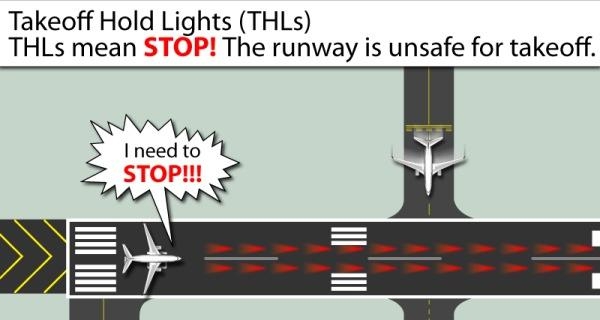Wed, Aug 31, 2011
Switched Automatically From Airport Surface Surveillance
Systems
The FAA has published an advisory circular to update pilots on
the installation of Runway Status Lights (RWSL). RWSL are a series
of red in-pavement lights that warn pilots of high-speed aircraft
or vehicles on runways which operate independently of Air Traffic
Control. Runway Status Lights have two states: ON (lights are
illuminated red) and OFF (lights are off) and are switched
automatically based on information from the airport surface
surveillance systems. RWSL will improve airport safety by
indicating when it is unsafe to enter, cross, or takeoff from a
runway. The RWSL system has two types of lights. Runway
Entrance Lights (RELs) are installed at taxiways and Takeoff Hold
Lights (THLs) on runways.

Runway Entrance Lights (RELs) are a series of red in-pavement
lights spaced evenly along the taxiway centerline from the taxiway
hold line to the runway edge. One REL is placed before the hold
line and one REL is placed near the runway centerline. RELs are
directed toward the runway hold line and are oriented to be visible
only to pilots entering or crossing the runway from that location.
RELs that are ON (illuminated red) indicate that the runway ahead
is not safe to enter or cross. Pilots should remain clear of a
runway when RELs along their taxi route are illuminated. Lights
that are off convey no meaning.
The system is not, at any time, intended to convey approval or
clearance to proceed into a runway. Pilots remain obligated to
comply with all ATC clearances, except when compliance would
require crossing illuminated red RELs. In such a case, the crews
should hold short of the runway for RELs, contact ATC, and await
further instructions.

The Takeoff Hold Light (THLs) system is composed of red
in-pavement fixtures in a double row on either side of the runway
centerline lighting. Fixtures are focused toward the arrival end of
the runway at the “Line Up and Wait” point and extend
in front of the holding aircraft beginning 375’ beyond the
runway threshold and extending for 1,500’. Illuminated red
lights provide a signal, to an aircraft in position for takeoff or
rolling, that it is unsafe to takeoff because the runway is
occupied or about to be occupied by another aircraft or ground
vehicle. THLs that are ON (illuminated red) indicate that the
runway ahead is not safe to takeoff. Pilots should refuse takeoff
clearance if THLs are illuminated. Red THLs mean do not takeoff.
Whenever a pilot observes the red lights of the THLs, the pilot
will stop or remain stopped. The pilot will contact ATC for
resolution if any clearance is in conflict with the lights. Lights
that are off convey no meaning. The system is not, at any time,
intended to convey approval or clearance to takeoff. Pilots must
still receive an ATC clearance to takeoff.
RWSL are in operation at DFW, SAN, LAX, BOS, and MCO. The system
will be operational at PHX, IAH, SEA, IAD, and LAS in 2012 and will
be installed at 23 major airports nationwide by 2016. (Graphics
provided by FAA)
More News
Aero Linx: Model Aeronautical Association of Australia MAAA clubs are about fun flying, camaraderie and community. For over 75 years, the MAAA has been Australia’s largest fl>[...]
Touchdown Zone Lighting Two rows of transverse light bars located symmetrically about the runway centerline normally at 100 foot intervals. The basic system extends 3,000 feet alon>[...]
“Discovery and innovation are central to our mission at Virgin Galactic. We’re excited to build on our successful record of facilitating scientific experiments in subor>[...]
How To Get A Story On Aero-TV News/Feature Programming How do I submit a story idea or lead to Aero-TV? If you would like to submit a story idea or lead, please contact Jim Campbel>[...]
Student Pilot Reported That During Rotation, “All Of A Sudden The Back Of The Plane Kicked To The Right..." Analysis: The student pilot reported that during rotation, “>[...]
 ANN's Daily Aero-Linx (05.02.24)
ANN's Daily Aero-Linx (05.02.24) ANN's Daily Aero-Term (05.02.24): Touchdown Zone Lighting
ANN's Daily Aero-Term (05.02.24): Touchdown Zone Lighting Aero-News: Quote of the Day (05.02.24)
Aero-News: Quote of the Day (05.02.24) ANN FAQ: Contributing To Aero-TV
ANN FAQ: Contributing To Aero-TV NTSB Final Report: Cirrus Design Corp SR20
NTSB Final Report: Cirrus Design Corp SR20




